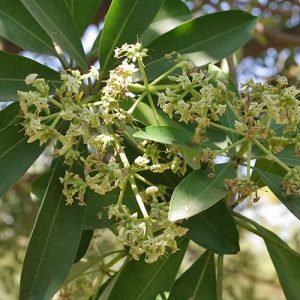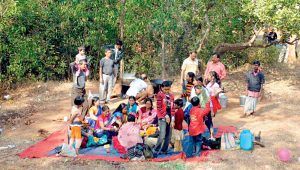What first rings your mind and tickles your nose when you think about winter in Bengal? For us, it’s a plethora of feelings, which start as the annual Kalipujo time tiptoes in. The air gets heavily laden with the smell of the Chhatim or Saptaparni flowers. And, of course, there’s a nip in the air, so the cotton head scarves come out as a protectional accessory during the Kali Pujo pandal hoppings and lighting firecrackers. Then there’s the unmistakably sweet yet heady scent of the Chhatim flowers forming a canopy over us around this time.

The evenings during Winter in Bengal
Chhatims don’t come alone. They invite the Shyama Pokas (green leaf hoppers) as well. So the army of Shyama Poka swarms each evening following various illuminating lamps, causing hindrances like itching or disturbing our tiny moments of peace during tea or Adda. But this used to add charm during our evening study time, and the same charm reflects today in the kids as we, now the parents, struggle to make them focus on their books. And why won’t it? After all, the primary combating technique involves switching off the lights for an hour or so!
However, the enticing charm of winter gets sided by the exam pressure, which has been scheduled during these precious months for ages.
Winter Vegetables
Winter in Bengal is the time when we comfort our eyes by visualizing the fresh green seasonal vegetables like Cabbages, Cauliflowers, French Beans, Peas, Spinach, Radish and Radish greens and so on. Although the long, red carrots are the late entrants. Ahh! Goodbye Bhindis and Potols, till the summer comes! It’s the best season for the gourmets when they can savour various cuisines.

While the vegetables get ready to fill our platters, fruits also do not take a seat back. Winter noon and oranges are unbeatable partners. The very smell of oranges in the fruit shops reminds us of the warm winter noons spent with syllabus books before exams & with story books after exams.
Comes out the Warm Clothes
The warm clothes are taken out from their coffins, smelling heavily of naphthalene balls and spread under the sun for a few hours. It’s still some time for the cold to set in, but Bengalis are always prepared with their sweaters, mufflers and monkey caps. But, alas! The monkey caps have yielded their place to balaclavas these days. The ‘image conscious’ Bengalis find them cooler than their predecessors.
The Best Time for Picnics & Sports
The other thing that winter in Bengal is very famous for is Picnics, which are now commonly known as day outings. Be it a school picnic, or parar picninc, the enthusiasm starts from the onset of winter and continues until the D-day arrived. The planning includes gathering friends, collecting money, deciding the venue, and what not! Nowadays, while picnics are not so common, one thing that continues is Sports Day & various other tournaments in different nooks and corners of Kolkata.

Along with these things, another sight had also stayed the same in the case of Bengali winter. That’s the sights of young boys and girls playing badminton inside the parks, corners of the roads, narrow bylanes – almost all over where it’s possible to squeeze in two players, two racquets, a badminton net and a shuttle cork.
And the Dryness of Winter in Bengal
Winter comes with the banes of chapped lips, dried skins, cracked heels and chilblains. Whatever may the skin problem be during the winter, the Bengalis always have one solution – the dark green, humble-looking tube of the Borolin ointment. We guess, almost all the Bongs will swear by Borolin as their one-stop winter skin problem solution and the unforgettable nostalgic aroma of the Lanolin, the principle ingredient used in making Borolin.
Come what may, it seems, these familiar harbingers of Bengali winter will always remain the same. The chhatims, the amateur badminton players, the ritual of sun warming the winter clothes, blankets and quilts, the Borolin, oranges – every single thing, for, the Bengalis, thrive over the nostalgia painted by these Winter Harbingers.

